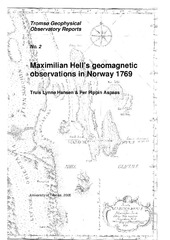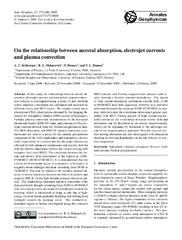Blar i forfatter "Hansen, Truls Lynne"
-
Maximilian Hell's geomagnetic observations in Norway 1769
Aspaas, Per Pippin; Hansen, Truls Lynne (Research report; Forskningsrapport, 2005)In the years 1768-1770 an expedition lead by the Austrian/Hungarian astronomer and Jesuit Father Maximilian Hell travelled to Vardø in the northernmost part of Norway. The main objective of the expedition was to observe the transit of Venus in June 1769. However, scientific investigations in several other fields were also performed, among them observations of the magnetic declination. From the ... -
On the relationship between auroral absorption, electrojet currents and plasma convection
Hansen, Truls Lynne; Kellerman, A. C.; Makarevich, R. A.; Honary, F. (Journal article; Tidsskriftartikkel; Peer reviewed, 2009-02-02)In this study, the relationship between auroral absorption, electrojet currents, and ionospheric plasma convection velocity is investigated using a series of new methods where temporal correlations are calculated and analysed for different events and MLT sectors. We employ cosmic noise absorption (CNA) observations obtained by the Imaging Riometer for Ionospheric Studies (IRIS) system in ... -
The Role of the Societas Meteorologica Palatina (1781–1792) in the History of Auroral Research
Aspaas, Per Pippin; Hansen, Truls Lynne (Journal article; Tidsskriftartikkel; Peer reviewed, 2012)The Societas Meteorologica Palatina, or Meteorological Society of Mannheim, was set up in 1781 to coordinate observations of the weather on an international scale. In addition to temperature, pressure and humidity, observers connected to the network were instructed to record various atmospheric phenomena, among these the aurora borealis. The 39 stations of the network reported about 1400 individual ...


 English
English norsk
norsk

